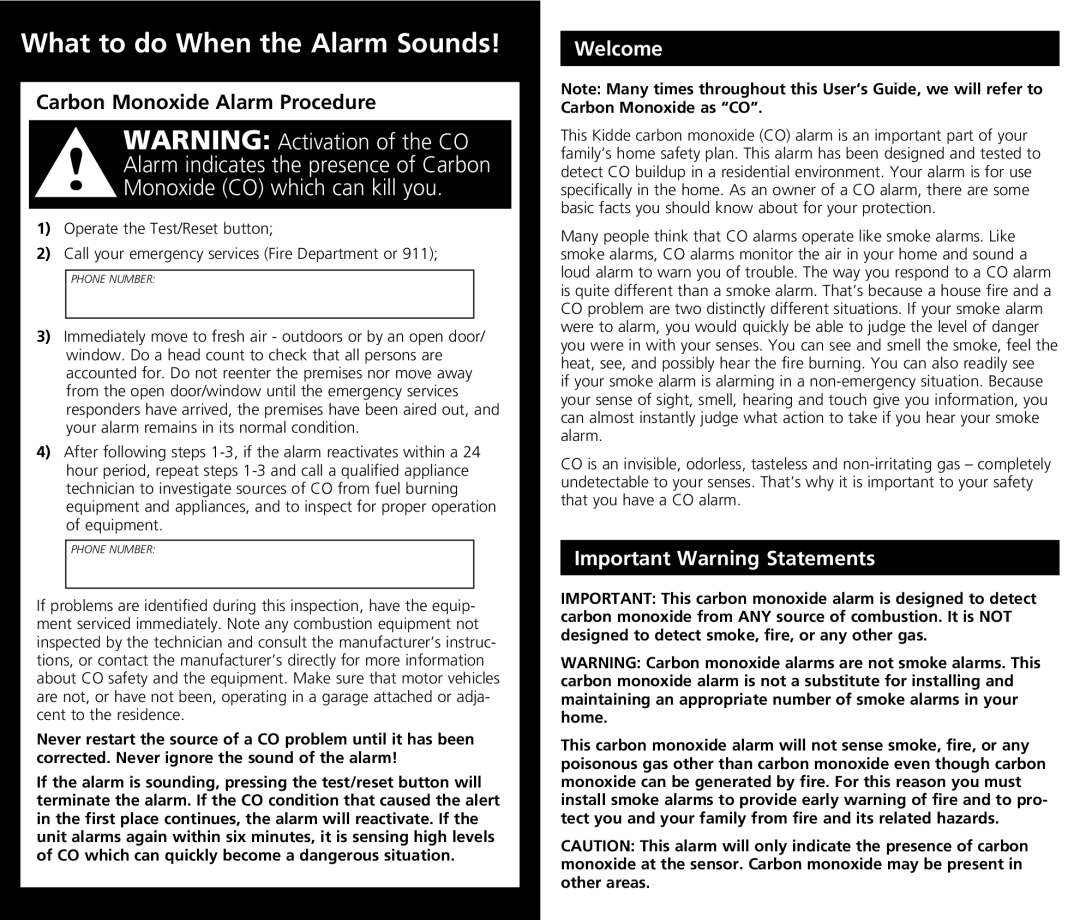
What to do When the Alarm Sounds!
Carbon Monoxide Alarm Procedure
![]() WARNING: Activation of the CO Alarm indicates the presence of Carbon Monoxide (CO) which can kill you.
WARNING: Activation of the CO Alarm indicates the presence of Carbon Monoxide (CO) which can kill you.
1)Operate the Test/Reset button;
2)Call your emergency services (Fire Department or 911);
PHONE NUMBER:
3)Immediately move to fresh air - outdoors or by an open door/ window. Do a head count to check that all persons are accounted for. Do not reenter the premises nor move away from the open door/window until the emergency services responders have arrived, the premises have been aired out, and your alarm remains in its normal condition.
4)After following steps
PHONE NUMBER:
If problems are identified during this inspection, have the equip- ment serviced immediately. Note any combustion equipment not inspected by the technician and consult the manufacturer’s instruc- tions, or contact the manufacturer’s directly for more information about CO safety and the equipment. Make sure that motor vehicles are not, or have not been, operating in a garage attached or adja- cent to the residence.
Never restart the source of a CO problem until it has been corrected. Never ignore the sound of the alarm!
If the alarm is sounding, pressing the test/reset button will terminate the alarm. If the CO condition that caused the alert in the first place continues, the alarm will reactivate. If the unit alarms again within six minutes, it is sensing high levels of CO which can quickly become a dangerous situation.
Welcome
Note: Many times throughout this User’s Guide, we will refer to Carbon Monoxide as “CO”.
This Kidde carbon monoxide (CO) alarm is an important part of your family’s home safety plan. This alarm has been designed and tested to detect CO buildup in a residential environment. Your alarm is for use specifically in the home. As an owner of a CO alarm, there are some basic facts you should know about for your protection.
Many people think that CO alarms operate like smoke alarms. Like smoke alarms, CO alarms monitor the air in your home and sound a loud alarm to warn you of trouble. The way you respond to a CO alarm is quite different than a smoke alarm. That’s because a house fire and a CO problem are two distinctly different situations. If your smoke alarm were to alarm, you would quickly be able to judge the level of danger you were in with your senses. You can see and smell the smoke, feel the heat, see, and possibly hear the fire burning. You can also readily see
if your smoke alarm is alarming in a
CO is an invisible, odorless, tasteless and
Important Warning Statements
IMPORTANT: This carbon monoxide alarm is designed to detect carbon monoxide from ANY source of combustion. It is NOT designed to detect smoke, fire, or any other gas.
WARNING: Carbon monoxide alarms are not smoke alarms. This carbon monoxide alarm is not a substitute for installing and maintaining an appropriate number of smoke alarms in your home.
This carbon monoxide alarm will not sense smoke, fire, or any poisonous gas other than carbon monoxide even though carbon monoxide can be generated by fire. For this reason you must install smoke alarms to provide early warning of fire and to pro- tect you and your family from fire and its related hazards.
CAUTION: This alarm will only indicate the presence of carbon monoxide at the sensor. Carbon monoxide may be present in other areas.
